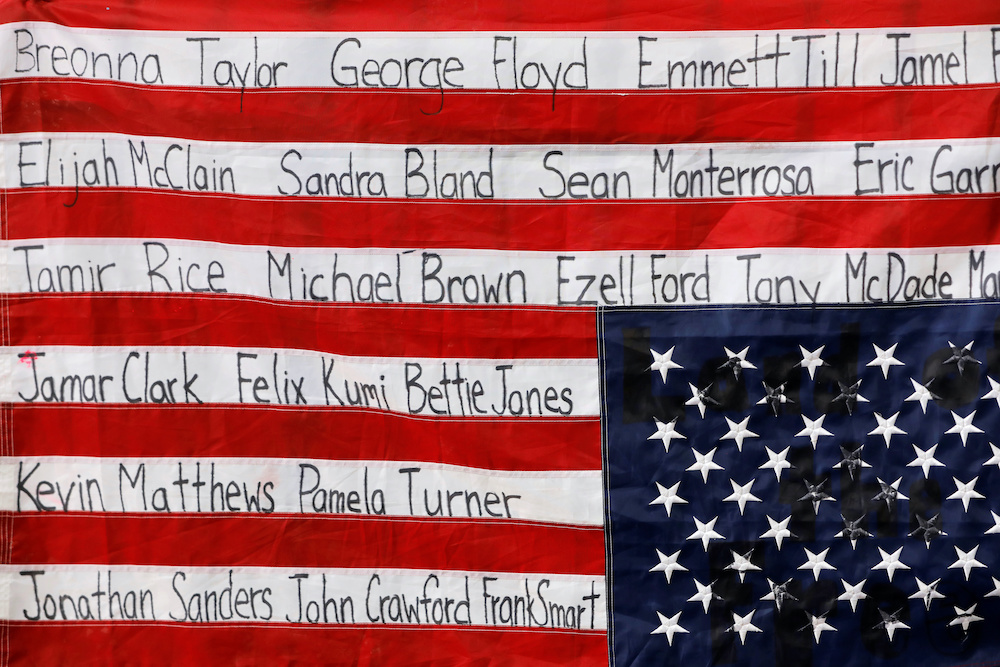
An American flag featuring the names of Black people killed by police is seen hanging at a protest to defund the police in New York City in June 2020
Buffeted by the ongoing Covid-19 pandemic, journalists around the globe were once again confronted with an array of obstacles to informing their audiences. In some cases, the impediment was subtle, like decades-old norms that prioritize the voices of law enforcement over the voices of the victims of police violence. In others, politicians marshalled the vast power of the state to intimidate news organizations and stop them from publishing critical stories. From covering voting rights to the harassment Indian journalists are subjected to on a daily basis, Nieman Reports tackled these issues and more. Here are five of our most important and timely feature stories:
1. Spurred by Black Lives Matter, Coverage of Police Violence Is Changing
In January, Adeshina Emmanuel looked at how the death of George Floyd and the countrywide protests prompted newsrooms to think differently about covering the police and framing the story when law enforcement takes someone’s life. As Emmanuel noted, reporters and editors have started prioritizing the stories of the victims over police narratives and concerns about property damage. “Context is key,” he wrote. “Police violence doesn’t just happen. We live in a society that creates the conditions for police violence, especially against Black people. Police are part of a system in which Black people live disproportionately in segregated, economically disinvested, over-policed communities ravaged by mass incarceration.”
2. Serving the Audiences Mainstream Newsrooms Don’t
This piece, published in May, details how a local, Korean-language outlet, helped the community grieve after eight people were killed in the Atlanta area. Clio Chang wrote about how community-based newsrooms focused on the victims — six of whom were women of Asian descent — while national media focused on the tragedy. Millions of people, especially minority and immigrant communities, rely on these outlets to get vital information in their own languages about the pandemic and other important stories.
3. Alexei Navalny, Social Media, and the State of the Free Press in Russia
In the past two decades, Russia’s independent press has diminished thanks to a combination of financial instability, media acquisitions, and crackdowns, Elizaveta Kuznetsova, wrote in June. But there are still some outlets, like MediaZona and Ekho Moskvy, able to carve out space to produce hard hitting journalism. Alexei Navalny and his followers have used social media platforms to reach larger audiences with information that state-owned media outlets won’t report. “Navalny’s success in reaching a large audience is emblematic of a new type of media consumer in Russia,” Kuznetsova noted. “Social media has opened up avenues for independent journalism, providing a small but growing alternative to federal networks … and meeting a demand for truthful reporting.
4. In India, the Last Few Bastions Of The Free Press Stand Guard Against Rising Authoritarianism
In the last seven years, India has become an increasingly dangerous place for journalists as Prime Minister Narendra Modi and his government have undermined the free press, calling it an enemy of the state. Those in the media have been subjected to threats, financial ruin, police investigation, ambushes by Modi’s political supporters, and harassment. But even as the situation devolves, audience-supported news outlets like The Wire and Caravan are stepping in to hold the Modi government to account. It’s a tenuous situation, however, that will require the people of India to step up and “decide the winner in the fight between the last few bastions of the free press and an increasingly authoritarian Modi administration,” wrote Vidya Krishnan.
5. The Media and the Ballot Box: Confronting 21st Century Voter Suppression
At least 19 states have enacted measures that the Brennan Center for Justice says will “make it harder for Americans to vote.” Several states have gerrymandered their state election map to make it difficult for Democrats to win federal House and state legislature seats. At the same time, few news organizations have the financial resources to dedicate reporters to voting rights — a beat that requires local sourcing and technical knowledge. Heading into the 2022 election, reporter Celeste Katz Marston writes about how news outlets, despite these challenges, can inform the public about the threats to their right to cast a ballot.

